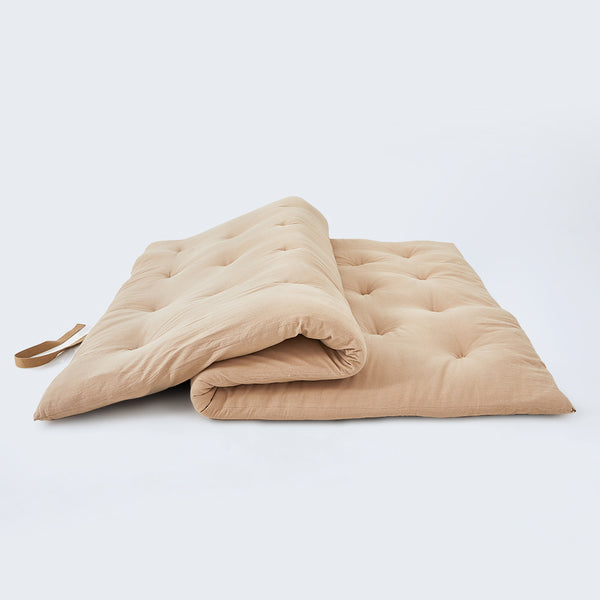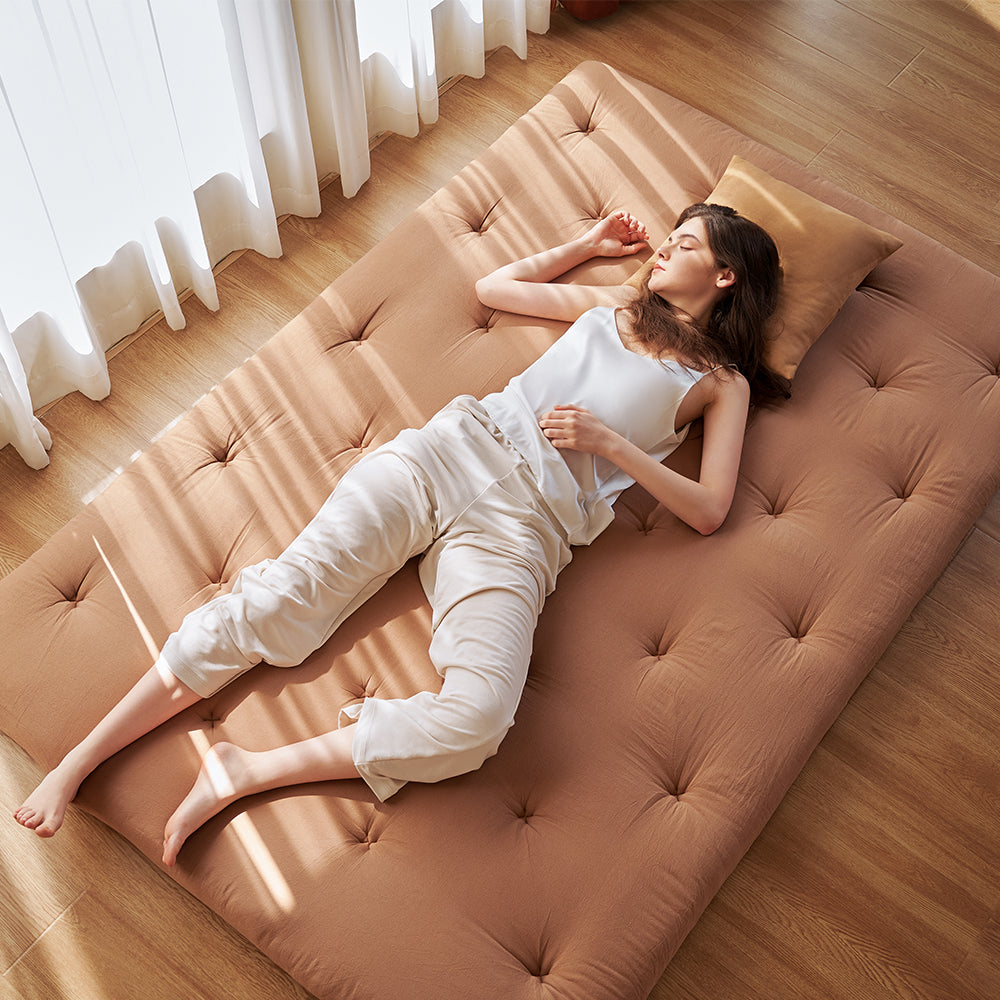Living with sciatica can turn the simple act of lying down into a daunting, painful ordeal. As nighttime approaches, the fear of triggering that familiar, piercing pain can become overwhelming. However, finding relief and reclaiming your night's rest is achievable with the right strategies and tools.
This detailed guide will help you learn how to sleep with sciatica, offering a comprehensive look at methods to alleviate discomfort and enhance sleep quality.
Understanding How to Sleep with Sciatica

Understanding the nuances of sciatica is essential for anyone looking to conquer its impact on sleep. This condition, marked by pain that follows the sciatic nerve's path from the lower back through the legs, can be exacerbated by prolonged periods in the wrong sleeping position. The discomfort ranges from mild aches to sharp, burning sensations, often on one side of the body.
Several factors can precipitate sciatica, including but not limited to lumbar herniated discs, degenerative disc disease, and piriformis syndrome. Each of these conditions can increase the vulnerability of the sciatic nerve to pressure and irritation.
Addressing these root causes through medical interventions and lifestyle adjustments forms the cornerstone of effective sciatica management.
Navigating Through Pain
The quest for sciatica relief at night begins with examining one's sleep environment. The mattress, pivotal to this setup, must provide comfort and support and adapt to the body's needs, ensuring minimal pressure on sensitive areas.
Floor Mattress as a Therapeutic Foundation
A floor mattress like the Zonli Futon Mattress can be revolutionary for those with sciatica. It offers a unique blend of firmness and ergonomic support, crucial for maintaining spinal alignment and minimizing pressure on the sciatic nerve. The low-to-ground aspect of floor mattresses can also facilitate more effortless mobility for those experiencing pain.
Ergonomic Support and Comfort
The Zonli Futon Mattress stands out with its five-tier structure, incorporating breathable cotton and high-density foam to create a supportive yet comfortable sleeping surface. This strategic composition is particularly beneficial for sciatica sufferers, offering a tailored sleep experience that addresses the need for a delicate balance between support and cushioning.
Optimizing Your Sleeping Position: A Key to Sciatica Management
Finding the proper sleeping position is paramount in alleviating sciatica pain. The goal is to reduce stress on the sciatic nerve by maintaining the spine's natural alignment.
- Back Sleeping Advantages: Lying on your back with a pillow under the knees can help flatten the lumbar spine, reducing the strain that can aggravate sciatica. The Zonli Futon Mattress provides an ideal surface for this position, supporting the lower back and allowing for proper spinal alignment.
- Side Sleeping Strategy: For side sleepers, aligning the hips is crucial. A pillow between the knees can prevent the pelvis from rotating and pulling the spine out of alignment, a common issue that can exacerbate sciatica symptoms.
- Avoiding Stomach Sleeping: This position can place undue stress on the back and neck, potentially worsening sciatica pain. Putting a thin pillow under the pelvis can help reduce the strain for those who find it difficult to avoid.
Tailoring Your Sleep Environment: Beyond the Mattress

While the choice of mattress is critical, other aspects of the sleep environment also play a significant role in managing sciatica.
Adjustable Pillows
Utilizing pillows to create additional support can make a significant difference. A pillow under the knees can reduce lower back strain for back sleepers, while side sleepers can benefit from a pillow between the knees to keep the hips aligned.
Maintaining a Regular Sleep Schedule
Consistency in sleep habits can also help manage sciatica symptoms. Going to bed and waking up at the same time daily helps regulate the body's internal clock, potentially reducing the frequency of sciatica flare-ups.
Temperature and Lighting
Creating a comfortable, calming sleep environment includes regulating the bedroom's temperature and minimizing light exposure. Cooler temperatures and dark, quiet rooms can facilitate deeper, more restorative sleep, which is crucial for healing and pain management.
FAQs
How does the Zonli Futon Mattress specifically cater to the needs of those with sciatica?
The Zonli Futon Mattress is designed with a focus on ergonomics and support, featuring a layered structure that promotes spinal alignment and reduces pressure on the sciatic nerve. This design is integral for those seeking relief from sciatica pain, as it addresses the critical balance between support and comfort.
How can I ensure my sleeping position on the Zonli Futon Mattress does not exacerbate my sciatica?
Experiment with different pillow placements to find what best supports your body's natural alignment. Back sleepers might place a pillow under their knees, while side sleepers could benefit from a pillow between their legs. Listening to your body and adjusting as needed can help identify the most comfortable and supportive sleeping position.
What additional steps can I take to enhance my sleep environment for sciatica relief?
Consider the overall ambiance of your bedroom. Ensure it's conducive to relaxation and free from disturbances. It might involve investing in blackout curtains, using white noise machines, or incorporating essential oils with calming properties. Each of these elements can contribute to a more soothing sleep environment, aiding in managing sciatica pain.
Can the type of bedding used on the Zonli Futon Mattress affect sciatica pain?
Yes, the choice of bedding can impact sciatica pain. Lightweight and breathable bedding materials can help maintain a comfortable sleeping temperature, reducing the likelihood of discomfort that might exacerbate sciatica symptoms. Also, choosing bedding that allows easy movement can prevent additional strain on the sciatic nerve during sleep.
Is using a mattress topper with the Zonli Futon Mattress beneficial for extra cushioning?
A mattress topper can provide additional cushioning and support, which may benefit some sciatica sufferers. However, it's crucial to select a topper that complements the firm backing of the futon mattress without compromising spinal alignment. Memory foam or latex toppers can offer a good balance between softness and support.
How does body weight influence the choice of sleeping solutions for sciatica?
Body weight can affect how a mattress supports the spine and distributes pressure. Individuals with higher body weight may require a mattress that offers firmer support to prevent sinking and misalignment of the spine, which could aggravate sciatica pain. Conversely, individuals with lower body weight may benefit from a slightly softer surface that still maintains proper spinal alignment.
Final Thoughts
Embracing floor mattresses as part of a holistic approach to managing sciatica can significantly improve sleep quality and reduce pain.
Understanding how to sleep with sciatica includes optimizing positions, curating a supportive sleeping environment, and using accessories for relief. With all these, people afflicted can navigate to restful nights and more comfortable days.

